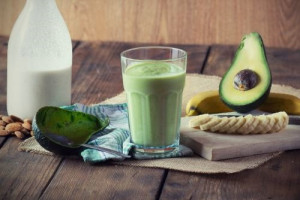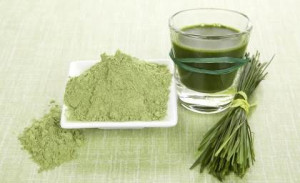Wheatgrass
NEWS: This superfood is now available in the SANEStore as a convenient whole-food powder so you can more easily enjoy it in smoothies and recipes.

Our raw organic Wheatgrass Powder is an easy way to enjoy all the wonderful benefits of this incredible green food.

Organic raw wheatgrass powder is a powerful detoxifier of the liver, blood, and gastrointestinal tract while chemically neutralizing toxins. The enzymes and amino acids found in wheatgrass can help protect the body from free radicals and carcinogens. Wheatgrass also stimulates metabolism and the body’s enzyme systems by enriching the blood and increasing red blood-cell count. It may also aid in reducing blood pressure by dilating the blood pathways throughout the body. Recent studies suggest that wheatgrass has a powerful ability to help fight tumors without the usual toxicity of drugs.
Wheatgrass Powder should not be confused with Wheatgrass Juice Powder. Wheatgrass Powder is made by drying the whole grass leaf and then milling it into a fine powder. Wheatgrass Juice Powder is made by first juicing the Wheatgrass and removing all of the cellulose so a pure juice concentrate is left. Then the juice is dried into a powder.
Wheatgrass is rich in protein and includes all eight of the essential amino acids, as well as 13 of the remaining 16 non essential amino acids. Besides containing most vitamins, minerals and an excellent source of living chlorophyll, organic wheatgrass has three other special components which make it particularly valuable:
- Superoxide Dismutase (SOD)
- P4D1 Enzyme
- Glycosaminoglycans (GAGs)
Superoxide Dismutase (SOD) – The aging process has been directly linked to decreasing amounts of SOD in our system. Increased amounts of SOD cause our body to repair itself quicker. Additionally SOD acts as an anti-inflammatory and cancer fighting enzyme.
P4D1 Enzyme – P4D1 has been found to do two things in the human body. It is the first known substance to actually stimulate repair of DNA molecules. It is possible that disease cells can be repaired with P4D1 so that when they reproduce they will actually produce good cells. P4D1 has also been shown in laboratory tests to eat the protein sheath off a cancer cell so that the white blood cells can attack and destroy them.
Glycosaminoglycans (GAGs) – GAGs form an important component in the synovial fluid lubricant in body joints, and chondroitins which can be found in connective tissues, cartilage and tendons.
Why Try Wheatgrass Superfood?
- Naturally improving energy
- High antioxidants content
- Improving digestion & regularity
- Neutralizing toxins
- Alkalizing the internal body
- Helping rebuild the immune system
- Providing raw building blocks for the hair, skin & nails
- Cleansing properties
- Promoting clear thinking
- Anti-aging properties
References
1. Murphy, Sean (2002-10-13). “Wheatgrass, healthy for the body and the bank account”. ABC Landline. Retrieved 2006-10-06.
2. Meyerowitz, Steve (April 1999). “Nutrition in Grass”. Wheatgrass Nature’s Finest Medicine: The Complete Guide to Using Grass Foods & Juices to Revitalize Your Health (6th ed.). Book Publishing Company. p. 53. ISBN 1-878736-97-3.
3. “Site Dedication and Construction Preliminaries, 1921-1923”. Ahr-kc.com. Retrieved 2013-04-19.
4.”USDA Nutrient Database”. Retrieved 2007-11-06.
5. “Wheatgrass”. American Cancer Society. November 2008. Retrieved August 2013.
6. de Vogel, Johan; Denise S. M. L. Jonker-Termont, Martijn B. Katan,and Roelof van der Meer (August 2005). “Natural Chlorophyll but Not Chlorophyllin Prevents Heme-Induced Cytotoxic and Hyperproliferative Effects in Rat Colon”. J. Nutr. (The American Society for Nutritional Sciences) 135 (8): 1995–2000. PMID 16046728.
7. Ferruzzia, Mario G.; Blakesleeb, Joshua (January 2007). “Digestion, absorption, and cancer preventative activity of dietary chlorophyll derivatives”. Nutrition Research 27 (1): 1–12. doi:10.1016/j.nutres.2006.12.003.
8. “Wheat grass | Memorial Sloan-Kettering Cancer Center”. Mskcc.org. Retrieved 2013-04-19.
9. Ben-Arye, E; Goldin, E; Wengrower, D; Stamper, A; Kohn, R; Berry, E (April 2002). “Wheat grass juice in the treatment of active distal ulcerative colitis: a randomized double-blind placebo-controlled trial”. Scand J Gastroenterol 37 (4): 444–9. doi:10.1080/003655202317316088. PMID 11989836.
10. Melina, Vesanto, MS, RD & Davis, Brenda, RD: “The New Becoming Vegetarian”, page 186-187. Healthy Living Publications, 2003.
11. “Nutrition Facts and Analysis for wheat grass”. Nutritiondata.self.com. Retrieved 2013-04-19.
12. Boardman, N.K. 1980. Energy from the biological conversion of solar energy. Phil. Trans. R. Soc. London A 295:477–489.
13. Briggle, L.W. 1980. Introduction to energy use in wheat production. p. 109–116. In: Pimenter, D. (ed.), Handbook of energy utilization in agriculture. CRC Press, Inc. Boca Raton, FL.
14. Briggle, L.W. 1981. Wheat. Triticum aestivum. p. 67–70. In: McClure, T.A. and Lipinsky, E.S. (eds.), CRC handbook of biosolar resources. Vol. 11. Resource materials. CRC Press, Inc. Boca Raton, FL.
15. C.S.I.R. (Council of Scientific and Industrial Research). 1948–1976. The wealth of India. 11 vols. New Delhi.
16. FAO. 1980a. 1979. Production yearbook. vol. 33. FAO, Rome.
17. Dibb, D.W. 1983. Agronomic systems to feed the next generation. Crops and Soils Mag. (Nov):5–6.
18. Duke, J.A. 1978. The quest for tolerant germplasm. p. 1–61. In: ASA Special Symposium 32, Crop tolerance to suboptimal land conditions. Am. Soc. Agron. Madison, WI.
19. Duke, J.A. 1981b. The gene revolution. Paper 1. p. 89–150. In: Office of Technology Assessment, Background papers for innovative biological technologies for lesser developed countries. USGPO. Washington.
20. Duke, J.A. and Wain, K.K. 1981. Medicinal plants of the world. Computer index with more than 85,000 entries. 3 vols.
21. Gohl, B. 1981. Tropical feeds. Feed information summaries and nutritive values. FAO Animal Production and Health Series 12. FAO, Rome.
22. Hartwell, J.L. 1967–1971. Plants used against cancer. A survey. Lloydia 30–34.
23. Jenkins, B.M. and Ebeling, J.M. 1985. Thermochemical properties of biomass fuels. Calif. Agric. 39(5/6):14–16.
24. Kvech, O. 1979. The importance of crop residues in rotations of an intense farming system. Rostlinna Vyroba 25(10):1013–1022.
25. Palz, W. and Chartier, P. (eds.). 1980. Energy from biomass in Europe. Applied Science Publishers Ltd., London.
26. Reed, C.F. 1976. Information summaries on 1000 economic plants. Typescripts submitted to the USDA.
27. Stewart, G.A., Gartside, G., Gifford, R.M., Nix, H.A., Rawlins, W.H.M., and Siemon, J.R. 1979. The potential for liquid fuels from agriculture and forestry in Australia. CSIRO. Alexander Bros., Mentone, Victoria, Australia.
28. Watt, J.M. and Breyer-Brandwijk, M.G. 1962. The medicinal and poisonous plants of southern and eastern Africa. 2nd ed. E.&S. Livingstone, Ltd., Edinburgh and London.








